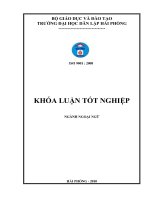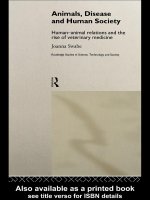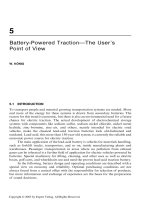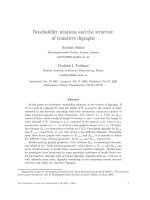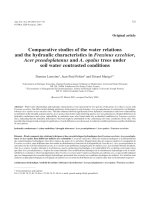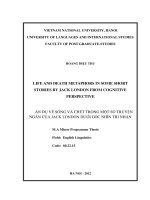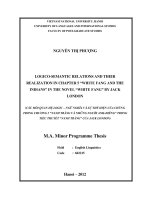logico-semantic relations and their realization in chapter 5 white fang and the indians in the novel white fang by jack london
Bạn đang xem bản rút gọn của tài liệu. Xem và tải ngay bản đầy đủ của tài liệu tại đây (708.13 KB, 62 trang )
VIETNAM NATIONAL UNIVERSITY, HANOI
UNIVERSITY OF LANGUAGES AND INTERNATIONAL STUDIES
FACULTY OF POST-GRADUATE STUDIES
NGUYỄN THỊ PHƯỢNG
LOGICO-SEMANTIC RELATIONS AND THEIR
REALIZATION IN CHAPTER 5 “WHITE FANG AND THE
INDIANS” IN THE NOVEL “WHITE FANG” BY JACK
LONDON
(CÁC MỐI QUAN HỆ LOGIC – NGỮ NGHĨA VÀ SỰ THỂ HIỆN CỦA CHÚNG
TRONG CHƯƠNG 5 “NANH TRẮNG VÀ NHỮNG NGƯỜI ANH-ĐIÊNG” TRONG
TIỂU THUYẾT “NANH TRẮNG” CỦA JACK LONDON)
M.A. Minor Programme Thesis
Field : English Linguistics
Code : 602215
Hanoi – 2012
VIETNAM NATIONAL UNIVERSITY, HANOI
UNIVERSITY OF LANGUAGES AND INTERNATIONAL STUDIES
FACULTY OF POST-GRADUATE STUDIES
NGUYỄN THỊ PHƯỢNG
LOGICO-SEMANTIC RELATIONS AND THEIR
REALIZATION IN CHAPTER 5 “WHITE FANG AND THE
INDIANS” IN THE NOVEL “WHITE FANG” BY JACK
LONDON
(CÁC MỐI QUAN HỆ LOGIC – NGỮ NGHĨA VÀ SỰ THỂ HIỆN CỦA CHÚNG
TRONG CHƯƠNG 5 “NANH TRẮNG VÀ NHỮNG NGƯỜI ANH-ĐIÊNG” TRONG
TIỂU THUYẾT “NANH TRẮNG” CỦA JACK LONDON)
M.A. Minor Programme Thesis
Field : English Linguistics
Code : 602215
Supervisor: Prof. Dr. Hoàng Văn Vân
Hanoi – 2012
vi
TABLE OF CONTENTS
Page
Declaration
i
Acknowledgements
ii
Abstract
iii
Notational conventions
iv
List of figures and tables
v
Table of contents
vi
PART A: INTRODUCTION
1. Rationale
1
2. Aim of the study and Research questions
2
3. Scope of the study
2
4. Data collection
3
5. Methods of the study
3
6. Design of the study
3
PART B: DEVELOPMENT
CHAPTER 1
THEORETICAL BACKGROUND
1.1. Introduction
4
1.2. What is functional grammar?
4
1.3. The role of Contextual Analysis
5
1.3.1. What is Context?
5
1.3.2. The Model of context
6
1.4. Grammatical rank scale
6
1.5. Clause and clause complex
8
1.5.1. Clause and its position in functional grammar
8
1.5.2. Clause simplex and clause complex
9
vii
1.6. Logico-semantic relations between clauses in clause complexes in
English
9
1.6.1. Expansion
12
a. Elaboration
13
Paratactic elaboration
13
Hypotactic elaboration
14
b. Extension
16
Paratactic extension
16
Hypotactic extension
17
c. Enhancement
18
Paratactic enhancement
19
Hypotactic enhancement
21
1.6.2. Projection
23
a. Paratactic projection
23
Paratactic locutions
23
Paratactic ideas
24
b. Hypotactic projection
25
Hypotactic locutions
25
Hypotactic ideas
25
1.7. Summary
26
CHAPTER 2
LOGICO-SEMANTIC RELATIONS BETWEEN CLAUSES IN
CLAUSE COMPLEXES IN CHAPTER 5 “WHITE FANG AND THE
INDIANS” IN THE NOVEL “WHITE FANG” BY JACK LONDON
2.1. Introduction
28
2.2. The context of the chosen text
28
2.3. Contextual configuration of the text
29
2.3.1. Field
29
viii
2.3.2. Tenor
29
2.3.3. Mode
29
2.4. The analysis of the text
30
2.5. Findings and discussions
30
2.5.1. Expansion
30
a. Elaboration
31
Paratactic elaboration
31
Hypotactic elaboration
31
b. Extension
33
Paratactic extension
33
Hypotactic extension
34
c. Enhancement
35
Paratactic enhancement
35
Hypotactic enhancement
36
2.5.2. Projection
39
a. Paratactic projection
39
Paratactic locutions
39
Paratactic ideas
39
b. Hypotactic projection
40
Hypotactic locutions
40
Hypotactic ideas
40
2.6. Concluding remarks
42
PART C: CONCLUSION
1. Recapitulation
43
2. Implications of the study
43
3. Suggestions for further study
44
REFERENCES 46
APPENDICES
1
PART A: INTRODUCTION
1. Rationale
Grammar is a description of logic. It is a description of a logical thinking
G46
process. Human beings first uttered distinctive sounds to convey thoughts.
Later, people made graphical representations of those sounds, a written language.
Finally, people analyzed the language to determine the patterns and variations. That
final step is GRAMMAR, an analysis of the way a language functions.
According to Lock (1996: 1), there are many ways of describing the
grammar of a language. One approach sees grammar as a set of rules which specify
all the possible grammatical structures of the language. Another approach sees
language first and foremost as a system of communication and analyzes grammar to
discover how it is organized to allow speakers and writers to make and exchange
meanings.
The former approach to grammatical analysis is often called formal, while
the latter approach is normally called functional.
Halliday (1994) considers functional grammar (FG) essentially as a „natural‟
grammar, in the sense that everything in it can be explained, ultimately, by
reference to how language is used.
There have been many studies concerning with different aspects of
functional grammar in which studies on the meaning and structure of a text also
mention the relationship between clauses in clause complexes. However, these
studies are only limited to surface relations or one of the two of the relations
between clauses in a clause complex. In other words, logico-semantic relations have
not been studied in details. Also, there have been some studies on logico-semantic
relations between clauses but they only focus on fairy tales, short stories, not on
novels.
2
For those reasons, I chose the novel “White Fang” written by Jack London to
investigate the logico-semantic relations between clauses in clause complexes. The
reason for my selecting the novel is not only because of its popularity but also
because of its precise prose style. Moreover, doing this research gives me a chance
to get to know the novel with lessons on bravery, patience, tolerance and love.
The novel consists of 20 chapters but I only choose Chapter 5 as the
illustrated material for the analysis because through this chapter, the logico-
semantic relations are realized quite clearly. As the result, readers can understand
more about the logico-semantic relations between clauses. Thus, my study will be
on Logico-semantic relations and their realization in chapter 5 “White Fang and
the Indians” in the novel “White Fang” by Jack London.
2. Aim of the study and Research questions
The aim of this thesis is to explore how logico-semantic relations are realized
in chapter 5 “White Fang and the Indians” in the novel “White Fang” by Jack
London.
In order to fulfill this aim, the following research questions are raised for
exploration:
1. What are logico-semantic relations?
2. How are they realized in chapter five of “White Fang” by Jack London?
3. Scope of the study
Given the aim and the research questions as set above, within the framework
of a minor M.A. thesis, the study cannot cover all aspects of functional grammar.
What it attempts to do is to confirm itself to the exploration of the logico-semantic
relations between clauses. This involves a review on the notions concerning the
clause complex and the logico-semantic relations between clauses.
As the aim of this thesis is to explore how the logico-semantic relations are
realized in chapter five of “White Fang” by Jack London, its second focus is on
analyzing chapter five “White Fang and the Indians” of the novel “White Fang” in
terms of logico-semantic relations.
3
4. Data collection
Data collected for analysis and discussion is from clauses in chapter 5
“White Fang and the Indians” in the novel “White Fang” by the noted American
writer, Jack London, which was published by Longman Group UK Limited in 1968.
5. Methods of the study
The study is conducted as an attempt to understand more about the nature of
logico-semantic relations between clauses in English and their realization in chapter
5 in the novel “White Fang”. Thus, descriptive and analytical methods will be used
as the principal ones for the study. The descriptive method is used to re-examine the
notions relating to the clause complex and its logico-semantic relations between
clauses. The analytical method is used to analyze the text (chapter five of “White
Fang”) in terms of logico-semantic relations.
6. Design of the study
The study is organized around 3 parts:
Part A states the reasons for choosing the topic, the aim, research questions,
the scope, data collection, the methods of the study, and the research design.
Part B, the main part of the study, consists of two chapters:
Chapter 1 – Theoretical Background – provides an overview of systemic
functional grammar, context and the role of context in interpreting meaning,
grammatical rank scale, clauses and clause complexes, the notion of taxis and the
logico-semantic relations between clauses in clause complexes.
Chapter 2 attempts to answer the question “How are logico-semantic
relations realized in Chapter 5 „White Fang and the Indians‟ in the novel „White
Fang‟ by Jack London?” This chapter analyzes chapter five of “White Fang” in
terms of logico-semantic relations, discusses and makes some comments on the
findings.
Part C draws some conclusions, makes some implications for teaching and
learning English and some suggestions for further research.
4
PART B: DEVELOPMENT
CHAPTER 1
THEORETICAL BACKGROUND
1.1. Introduction
This chapter reviews some basic concepts that set the theoretical orientation
for the study. The chapter focuses on five parts: (1) what is functional grammar? (2)
the role of contextual analysis, (3) grammatical rank scale, (4) clause and clause
complex, and (5) logico-semantic relations between clauses in clause complexes in
English.
1.2. What is functional grammar?
According to Martin, et al. (1997: 1), “functional grammar is a way of
looking at grammar in terms of how grammar is used. In the field of linguistics, the
main alternative to functional grammar is formal grammar, which is concerned with
the ways in which our genes constrain the shape of our grammars, and thus
constrain what we can and cannot say.” Martin, et al. state that functional grammar
focuses on the development of grammatical systems as a means for people to
interact with each other. It provides us with tools for understanding why a text is
the way it is. A functional grammar is a grammar that respects speakers‟ rights to
make up their own minds about how they choose to talk; at the same time it makes
speakers explicitly aware of the choices they have available, so they can make an
informed decision about the options they choose. Its orientation is social, in other
words, rather than biological.
For Halliday, language is “a network of systems or interrelated sets of
options for making meaning” (Halliday, 1994: 15), thus language is “systemic”. The
term „functional‟ is used to indicate that the approach is concerned with meaning.
5
Functional grammar, in Thompson‟s (1996: 8) view, sets out to investigate
what the range of relevant choices are, both in the kinds of meanings that we might
want to express (or functions that we might want to perform) and in the kinds of
wordings that we can use to express these meanings; and to match these two sets of
choices.
Functional Grammar seeks to be a theory which is “functional” in at least
three different, though interrelated senses: (i) it takes a functional view on the
nature of language; (ii) it attaches primary importance to functional relations at
different levels in the organization of grammar; (iii) it wishes to be practically
applicable to the analysis of different aspects of language and language use.
1.3. The role of contextual analysis
1.3.1. What is context?
In linguistics, the term „context‟ has been used quite commonly. So what is
context? For some scholars, context seems just to be the minimal stretch of
language that helps to understand what is written and spoken (Brown & Yule, 1983:
35). Nunan (1993: 7) considers context as an important concept in discourse
analysis. According to him, “context refers to the situation giving rise to the
discourse, and within which the discourse is embedded.” (Nunan, 1993: 7 - 8)
In the view of Hymes (1962) (cited in Brown and Yule, 1983: 38), “A
context can support a range of meanings. When a form is used in a context it
eliminates the meanings possible to that context other than those the form can
signal: the context eliminates from consideration the meanings possible in the form
other than those the context can support.”
From a complementary perspective, Hoang Van Van (2006: 40) sees context
as „the situation in which the text or the linguistic interaction takes place gives the
participants a great deal of information about the meanings that are being
exchanged, and the meanings that are likely to be exchanged‟. And context,
6
according to Nguyen Hoa (2000: 40), is the non-linguistic factor that contributes
and constrains the interpretation of discourse.
1.3.2. The Model of context
Halliday in Halliday & Hasan (1989) (cited in Hoang Van Van, 2006: 40 -
41) develops a model for contextual analysis which consists of three components or
parameters: field (of discourse), tenor (of discourse), and mode (of discourse). His
model of context can be represented as follows:
Field of discourse refers to what is happening, to the nature of the social
action, that is taking place: what is it that the participants are engaged in, in which
the language figures as some essential components?
Tenor of discourse refers to who is taking part, to the nature of the
participants, their statuses and roles: what kind of role relationships of one kind or
another, both the types of speech role that they are taking on in the dialogue and the
whole cluster of socially significant relationships in which they are involved?
Mode of discourse refers to what part the language is playing, what it is that
the participants are expecting the language to do for them in that situation: the
symbolic organization of the text, the status that it has, and its function in the
context, including the channel (is it spoken or written or some combination of the
two?) and also the rhetorical mode, what is being achieved by the text in terms of
such categories as persuasive, expository, didactic, and the like.
(Halliday in Halliday & Hasan, 1989: 12)
1.4. Grammatical rank scale
A rank scale consists of the following four ranks: clause, group, word, and
morpheme, as shown in Figure 1 below.
7
Clauses
e.g. |||Computer facilities are free of charge.|||
are made up of one or more
groups
e.g. |||[computer facilities][are][free of
charge]|||
are made up of one or more
words
e.g. [{computer} {facilities}]
are made up of one or more
morphemes
e.g. {compute er} {facility s}
Combine into clause complexes
e.g. |||If this applies to you ||
tick this box.|||
combine into group complexes
e.g. |||[Mark \\ and I]
[tried to \ help]|||
Fig. 1: The rank scale
Source: Thompson (1996: 22)
As can be seen from the rank scale, the clause is the largest grammatical unit
in the scale and the smallest is the morpheme. Thompson (1996: 21) explains the
reason why there is no „sentence‟ rank above clause. He says that the main reason is
that we can adequately account for sentences by introducing the concept of clause
complexes: two or more clauses linked by coordination and/ or subordination in a
larger structural unit. This sounds very much like the traditional description of a
sentence. However, according to him, the sentence is an idealization of the written
language which it is often difficult to impose on spoken language. We also find that
full stops, which mark the boundaries of sentences in writing, may be used between
clauses which are grammatically dependent on each other. The term „sentence‟ is
therefore best reserved to label stretches of written text bounded by full stops or the
equivalent. Typically, written sentences correspond to clause complexes.
Traditionally, a series of related clauses has been seen as making up the
higher rank unit of „sentence‟. However, Halliday, cited in Martin, et al. (1997: 165
- 166), argues that when clauses combine to form a clause complex, they do not
8
thereby create a new grammatical unit of higher rank. His position is that the
sentence is not a unit of grammar, but a unit of English orthography, realizing the
grammatical construction clause complex. The two interpretations of the status of
„sentence‟ are illustrated in Fig. 2, with as the traditional view and as the IFG
position.
… …
Fig.2: Sentence and clause complex
Source: Martin, et al. (1997: 166)
1.5. Clause and Clause Complex
1.5.1. Clause and its position in functional grammar
According to Jacobs (1995: 49), clauses are constructions with one phrase
constituent, typically a noun phrase, which bears the subject relation and another
constituent, the verb phrase, bearing the predicate relation. In functional grammar,
clause is referred to „a constituent unit‟ (Halliday, 1994: 16). In fact, a clause can be
Sentence
Clause complex
RANK SCALE
clause
group/ phrase
COMPLEXING
clause -> clause -> clause ->… =
group/ phrase
sentence (as graphological
unit in writing)
9
seen as the basic unit of functional grammar because „it has a special place in
expressing meaning because at this rank we can begin to talk about how things
exist, how things happen and how people feel in the world around us. It is also at
the rank of clause that we usually use language to interact with others‟ (Bloor, 1995:
7).
1.5.2. Clause simplex and clause complex
In Halliday‟s grammar, clauses can be divided into clause simplex and clause
complex. Clause simplex contains one clause, whereas clause complex contains a
Head clause together with other clauses that modify it. Downing & Locke (1992:
274) define clause complex as “a unit consisting of two or more clauses related
either paratactically or hypotactically, but not by embedding.” (An embedded
clause, also according to Downing & Locke (1992: 274), functions as a constituent
of another, superordinate clause. A conjoined clause or a dependent clause does not
function as a constituent of another clause). The notion of „clause complex‟, as
Halliday (1994: 216) states, “enables us to account in full for the functional
organization of sentences.”
The separation of a clause complex from the other is represented by three
vertical strokes |||…||| while two vertical strokes ||…|| are used between two clause
simplexes. And embedded clauses are put in square brackets […]. Below is an
example:
|||Then he heard something: || the Indians heard it too. |||The cub ceased his crying ||
and waited for the coming of his mother – his wonderful mother [who had fought
and killed all things and was never afraid.]|||
(London, 1989: 18)
1.6. Logico-semantic relations between clauses in clause complexes in English
As we all know, in traditional grammar, a sentence is considered as the
highest unit, which may be classified into 4 types by structure: simple, compound,
complex, and compound-complex sentences. In compound, complex and
10
compound-complex sentences, clauses are linked with each other by coordination
or/ and subordination. Similarly, in functional grammar, a clause is referred to as
the largest grammatical unit, which can be divided into clause simplex and clause
complex. Clauses in a clause complex are linked by a means of conjunctions. In
traditional grammar, coordination is a symmetrical relation, holding between two
independent clauses while subordination is a non-symmetrical relation, holding
between two clauses in such a way that one is a constituent or part of the other
(Quirk & Greenbaum, 1987: 309). Like this, in functional grammar, conjunctions
used to link clauses in a clause complex show equal and unequal or hierarchical
relations between them. This type of relation is TAXIS. However, the relationship
between clauses in a clause complex is not simply realized in terms of taxis. In
other words, one clause in a clause complex is linked to another in terms of a
particular LOGICO-SEMANTIC relationship. Then, we can say that clauses within
a complex are interrelated grammatically in terms of two systems, those of TAXIS
and LOGICO-SEMANTIC TYPE. This makes functional grammar quite different
from traditional grammar and a clause complex dissimilar to a sentence.
So, what are taxis and logico-semantic relations in English and how are they
related to each other? To answer these questions this chapter attempts to re-examine
both taxis and logico-semantic relations between clauses in clause complexes in
English, mainly based on Halliday‟s functional grammar. Although the main
purpose of the chapter is to discuss logico-semantic relations between clauses in
clause complexes in English, the type of taxis needs to be reviewed because logico-
semantic relations can be paratactic or hypotactic. Then, two types of logico-
semantic relations which are expansion and projection are investigated in detail.
The findings will serve as the framework for the analysis in the next chapter, with
the hope to discover the features hidden in the text.
Taxis
Taxis, or interdependency, indicates the logical interdependency between
clauses in a clause complex, i.e. it shows whether one clause is dependent on or
11
dominates another, or whether they are of equal status. The two kinds within the
system of TAXIS are parataxis and hypotaxis.
Parataxis is the logical interdependency between clauses where the clauses
in the nexus are of equal status, one initiating and the other continuing. Both the
initiating and the continuing element are free, in the sense that each could stand as a
functioning whole. In principle, the paratactic relation is logically symmetrical and
transitive. This can be exemplified with the „and‟ relation. For paratactic structures
we shall use a numerical notation 1 2 3…, with nesting indicated in the usual way:
11 12 2 31 32 means the same as 1(1 2) 2 3(1 2).
||| John ran away, || and Fred stayed behind.|||
1 2
Hypotaxis, in Halliday (1994: 221), is the binding of elements of unequal
status. The dominant element is free, but the dependent element is not. The
hypotactic relation is logically non-symmetrical and non-transitive. Hypotactic
structures will be represented by the Greek letter notation , , , … in which an
alpha () is used for the dominant, a beta () is used for a clause dependent on it,
and a gamma () is used for one dependent on that, and so on. Below is an example:
||| We‟re going to buy an intercom system || so that we can hear Stephen in
different parts of the house || whenever he cries.|||
A hypotactic clause complex will not necessarily have the alpha clause as the
initial clause in the sequence, so this notation is sequenced to indicate the
dependency relations.
||| As they walked along the dark fen meadow || he watched the moon.|||
(Martin, J. R., et al., 1997: 169)
According to Halliday (1994: 218), a typical clause complex is a mixture of
paratactic and hypotactic sequences, either of which may be nested inside the other.
12
||| I would || if I could,|| but I can‟t. |||
1
1
2
There is a paratactic relationship between I would if I could and but I can‟t,
shown as 1 2; and a hypotactic relationship between I would and if I could, shown
as .
To sum up, the type of INTERDEPENDENCY, or TAXIS is referred to as a
CLAUSE NEXUS. The clauses making up such a nexus are PRIMARY and
SECONDAY. The primary is the initiating clause in a paratactic nexus, and the
dominant clause in a hypotactic; the secondary is the continuing clause in a
paratactic nexus and the dependent clause in a hypotactic. This is set out in Table 1.
Table 1: Primary and secondary clauses
Primary
Secondary
Parataxis
1 (initiating)
2 (continuing)
Hypotaxis
(dominant)
(dependent)
(Halliday, 1994: 218 - 219)
Types of logico-semantic relations
As stated above, one clause in a clause complex is linked to another not only
in terms of taxis, but also in terms of a particular logico-semantic relationship.
Halliday (1994: 219 - 220) says that there is a wide range of different logico-
semantic relations any of which may hold between a primary and a secondary
member of a clause nexus. But it is possible to group these into a small number of
general types, based on the two fundamental relationships of (1) EXPANSION and
(2) PROJECTION.
1.6.1. Expansion
Expansion is one of the two types of logico-semantic relations between
clauses in a clause complex. In expansion, „one clause expands the meaning of
another in some way‟ (Downing & Locke, 1992: 279). According to Halliday
13
(1994: 219), in expansion, the secondary clause expands the primary clause by
elaborating it, extending it or enhancing it, either paratactically or hypotactically. In
other words, expansion can be classified into three kinds: elaboration, extension,
and enhancement.
a. Elaboration
According to Halliday (1994: 225), in elaboration, one clause elaborates on
the meaning of another by further specifying or describing it. The second clause
does not introduce a new element into the picture but rather provides a further
characterization of one that is already there, restating it, clarifying it, refining it, or
adding a descriptive attribute or comment. The elaborating relation is symbolized in
the notation with an „equals‟ sign (=).
In a paratactic elaborating complex „an initial clause is restated, exemplified
or further specified by another‟ (Martin, et al., 1997: 171). The symmetry of this
type of clause complex is reflected in punctuation by the use of the semi-colon,
colon or dash. Paratactic elaboration can be divided into three subtypes: exposition,
exemplification, and clarification.
Exposition: Here the secondary clause restates the thesis of the primary
clause in different words, to present it from another point of view, or perhaps
just to reinforce the message (Halliday, 1994: 226). Conjunctive expressions
include: in other words, or rather, that is (to say), specifically, namely, as
follows, i.e. (in writing). For example:
This picture is not an original, in other words, it‟s a forgery.
(Downing & Locke, 1992: 283)
Exemplification: Here the secondary clause develops the thesis of the
primary clause by becoming more specific about it, often citing an actual
14
example (Halliday, 1994: 226). Conjuncts include: for example, for instance,
in particular, e.g. (in writing). For example:
There are lots of things you might do - for example, you might learn to play
a musical instrument. (Downing & Locke, 1992: 284)
Clarification: In this case the secondary clause clarifies the thesis of the
primary clause, backing it up with some form of explanation or explanatory
comment (Halliday, 1994: 226). The cohesive conjuncts are: in fact, indeed,
actually, at least. For example:
I didn‟t mind their questions - indeed, I was glad to be able to answer them.
(Downing & Locke, 1992: 284)
In a hypotactic elaborating complex, the dependent clause - realized by a
„non-restrictive‟ relative clause - provides some kind of elaborating description or
comment (Martin, et al., 1997: 171). According to Halliday (1994: 227), these
dependent clauses may be either finite or non-finite.
Finite clauses
According to Downing & Locke (1992: 284), in both spoken and written
English, non-restrictive relative clauses differ from the restrictive or defining type
in both meaning and expression. With regard to meaning, non-restrictive relative
clauses do not define subsets, as does the restrictive type. Their function is to add a
further specification of something that is already presented as specific. Halliday
(1994: 227) states that it is helpful to treat the non-defining relative under three
headings, although these are not sub-types, simply convenient groupings:
Clauses with which whose domain is either the whole of the primary clause
or some part of it that is more than a nominal group. For example:
15
They decided not to go, which turned out to be a mistake.
(Downing & Locke, 1992: 284)
Clauses with which, who or whose whose domain is a nominal group. For
example:
She was hard at work on the white kitten, which was lying quite still.
(Halliday, 1994: 227)
Clauses with when or where, having as domain some expression of time or
place. For example:
We should be ready by July, when the holidays start.
(Downing & Locke, 1992: 285)
The dominant and dependent clauses are linked by „tone concord‟ in speech,
while in writing a comma or dash can be expected to separate them. The beta clause
may elaborate just one participant in the alpha clause, in which case it often occurs
next to that participant, interrupting or included in the alpha clause. For example:
His mother, who had been watching them all evening, made her way over.
(Martin, et al., 1997: 171 - 172)
Non-finite clauses
The non-finite verb forms -ing, to-infinitive and –en participle are used non-
restrictively to express the same meanings as the finite forms. (Downing & Locke,
1992: 286). For example:
I worked for a local firm at that time, selling office equipment.
It‟s my own invention - to keep clothes and sandwiches in.
The mountains were invisible, enveloped in a thick mist.
16
b. Extension
According to Halliday (1994: 230), in extension, one clause extends the
meaning of another by adding something new to it. What is added may be just an
addition, or a replacement, or an alternative. The extending relation is symbolized in
the notation with an „addition‟ sign (+).
The combination of parataxis and extension gives coordination between
clauses. It is expressed by the coordinating conjunctions and, or, nor and but. These
are often accompanied by cohesive expressions such as too, in addition, moreover,
also, on the other hand (Downing & Locke, 1992: 287). Paratactic extension
includes addition, variation and alternation.
Addition
Two situations are represented as adjoined in a relationship of equality that is
positive, negative or adversative. Halliday (1994: 230) states that in paratactic
addition, there is no implication of any causal or temporal relationship between
them. For example:
He doesn‟t like bacon, and also he‟s better without it. (positive)
I have no intention of going, nor in fact did I ever promise to. (negative)
It‟s an extremely simple device, but actually it‟s very effective. (adversative)
Additive conjuncts include also, furthermore, in addition, besides.
Adversative conjuncts include in fact, actually, as a matter of fact.
(Downing & Locke, 1992: 287)
Variation
Here „one clause is presented as being in total or partial replacement of
another‟ (Halliday, 1994: 230). Variation conjuncts include instead, on the
contrary, but, and only. For example:
He didn‟t stay even an hour, but instead returned to London on the next
train.
17
Peaches are marvelous just now, only they are very expensive.
(Downing & Locke, 1992: 288)
Alternation
According to Downing & Locke (1992: 287), alternative coordination is
expressed by or, the second clause presenting an alternative to the first. The
meaning can be reinforced by adding else (or else) and by preceding the first unit by
either (either…or). Cohesive conjuncts associated with this meaning include
alternatively, conversely, on the other hand. For example:
You can add the wine to the water: conversely, you can add the water to the wine.
There are several medium-priced hotels: alternatively, self-catering facilities are
available.
From Halliday‟s (1994: 231) point of view, the combination of extension
with hypotaxis also embraces addition, replacement and alternation, but with the
extending clause dependent. The dependent clause may be finite or non-finite.
Finite clauses
Hypotactic clauses of addition are introduced by the conjunctions whereas,
while. In this case, the dependent clause contrasts in some way with the primary
clause, especially when there is also some point of similarity between the two. For
example:
She likes tea, while I prefer coffee.
(Oxford learner‟s pocket dictionary, 2008: 506)
Jane already speaks two foreign languages, whereas her brother hasn‟t yet
learned any. (Downing & Locke, 1992: 289)
The hypotactic form which expresses the meaning of alternation is if…not,
and corresponds to either…or in paratactic combinations. For example:
If you haven‟t lost it, then it‟s in that cupboard.
18
(= Either you‟ve lost it, or else it‟s in that cupboard)
(Halliday, 1994: 231)
For subtraction the finite clause is introduced by except that, but (for the
fact) that. For example:
I‟d take you to the station, except that the car is being repaired.
(Downing & Locke, 1992: 289)
Non-finite clauses
According to Downing & Locke (1992: 289), non-finite dependent clauses
which extend the meaning of the primary clause by contributing additive, replacive,
adversative, and subtractive meanings are usually -ing clauses, often introduced by
such prepositions as besides, instead of, without, other than, functioning
conjunctively. Halliday (1994: 231) calls the non-finite form of hypotactic
extending an imperfective clause. For example:
Besides breaking her leg, she caught a bad throat infection. (additive)
Instead of turning down that side road, you should have kept straight on.
(replacive)
He has embarked on a huge project, without realizing what is involved.
(adversative)
You won‟t get any information from him other than by paying him.
(subtractive)
(Downing & Locke, 1992: 290)
c. Enhancement
According to Halliday (1994: 232), in enhancement, one clause enhances the
meaning of another by qualifying it in one of a number of possible ways: by
reference to time, place, manner, cause or condition. Enhancing clauses can be in a
paratactic or a hypotactic relationship to the primary clause. The enhancing relation
is symbolized in the notation with a „multiple‟ sign (x).
19
The combination of parataxis and circumstantial meaning gives a kind of
coordination reinforced by a circumstantial element. There are four subtypes of
enhancement: temporal (time), spatial (place), manner (means) and causal-
conditional.
Temporal
Temporal relation can be signaled by a conjunction or a conjunction group
such as now, (and) then, (and) afterwards, first…then, and just then, at the same
time, and at this time. For example:
The lights have gone out: now we won‟t be able to do any more.
They spread the cloth on the grass and then began unpacking the picnic
things.
(Downing & Locke, 1992: 291)
Spatial
Spatial relation is introduced by „and there‟ to denote the same place. For
example: She turned the corner, and there stood Robin waiting for her.
(Downing & Locke, 1992: 291)
Manner
Manner consists of means and comparison
Means: (and) (in) that way. For example:
Keep on subtracting the difference, and in that way you will arrive at the correct
figure. (Halliday, 1994: 234)
Comparison: (and) similarly, in the same way, likewise, and so, and
neither,… For example:
She likes the simple life, and so does he. (Halliday, 1994: 234)
20
Causal-conditional
Cause may consist of reason and purpose
Cause - effect relation can be introduced by conjunctions (and) so,
therefore. For example:
He was hurt so I helped him.
(Oxford learner‟s pocket dictionary, 2008: 420)
Effect - cause relation can be introduced by for. For example:
We left in silence, for there was little we could say.
(Downing & Locke, 1992: 291)
Condition may be positive, negative or concessive
Condition (positive): and then, (and) in that case. For example:
You might have an accident, and in that case who would rescue you?
(Downing & Locke, 1992: 292)
Condition (negative): otherwise, or else. For example:
You‟d better return it immediately; otherwise they‟re likely to accuse you
of stealing it. (Lock, 1996: 259)
Condition (concessive)
- Concession - consequence: still, yet, though. For example:
I didn‟t get the job though I had all the necessary qualifications. (Murphy, 1994:
224)
- Consequence – concession: consequently, as a result. For example:
He had not taken the precaution of being vaccinated; consequently, he got malaria.
(Downing & Locke, 1992: 292)
